Portal:Stars/Selected article
If you found any nice article on star, do make a link here.
Usage[edit]
- Add a new selected article to the next available subpage. [[Portal:Star/Selected article/#]] - {{/#}}
- Update "max=" to new total for its {{Random portal component}} on the main page.
Nominations[edit]
Please see Portal:Star/Nominate/Selected article for nominations.
Selected articles list[edit]
Portal:Star/Selected article/1
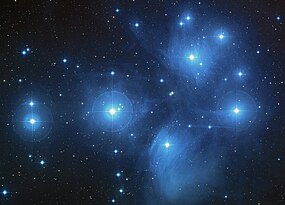
In astronomy, the Pleiades, or Seven Sisters (Messier object 45), is an open star cluster containing middle-aged hot B-type stars located in the constellation of Taurus. It is among the nearest star clusters to Earth and is the cluster most obvious to the naked eye in the night sky. Pleiades has several meanings in different cultures and traditions.
The cluster is dominated by hot blue and extremely luminous stars that have formed within the last 100 million years. Dust that forms a faint reflection nebulosity around the brightest stars was thought at first to be left over from the formation of the cluster (hence the alternate name Maia Nebula after the star Maia), but is now known to be an unrelated dust cloud in the interstellar medium that the stars are currently passing through. Astronomers estimate that the cluster will survive for about another 250 million years, after which it will disperse due to gravitational interactions with its galactic neighborhood.
The Pleiades are a prominent sight in winter in the Northern Hemisphere and in summer in the Southern Hemisphere, and have been known since antiquity to cultures all around the world, including the Māori (who call them Matariki) and Australian Aborigines, the Persians (who called them Parveen/parvin and Sorayya), the Chinese, the Maya (who called them Tzab-ek), the Aztec (Tianquiztli), and the Sioux and Cherokee of North America.
Portal:Star/Selected article/2

A supernova (plural supernovae) is a stellar explosion that is more energetic than a nova. Supernovae are extremely luminous and cause a burst of radiation that often briefly outshines an entire galaxy, before fading from view over several weeks or months. During this short interval a supernova can radiate as much energy as the Sun is expected to emit over its entire life span. The explosion expels much or all of a star's material at a velocity of up to 30,000 km/s (a tenth the speed of light), driving a shock wave into the surrounding interstellar medium. This shock wave sweeps up an expanding shell of gas and dust called a supernova remnant.
Several types of supernovae exist. Types I and II can be triggered in one of two ways, either turning off or suddenly turning on the production of energy through nuclear fusion. After the core of an aging massive star ceases to generate energy from nuclear fusion, it may undergo sudden gravitational collapse into a neutron star or black hole, releasing gravitational potential energy that heats and expels the star's outer layers.
Alternatively a white dwarf star may accumulate sufficient material from a stellar companion (either through accretion or via a merger) to raise its core temperature enough to ignite carbon fusion, at which point it undergoes runaway nuclear fusion, completely disrupting it. Stellar cores whose furnaces have permanently gone out collapse when their masses exceed the Chandrasekhar limit, while accreting white dwarfs ignite as they approach this limit (roughly 1.38 times the mass of the sun). White dwarfs are also subject to a different, much smaller type of thermonuclear explosion fueled by hydrogen on their surfaces called a nova. Solitary stars with a mass below approximately nine solar masses, such as the Sun, evolve into white dwarfs without ever becoming supernovae.
Portal:Star/Selected article/3
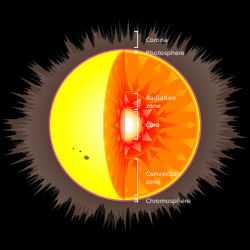
The main sequence is a continuous and distinctive band of stars that appear on plots of stellar color versus brightness. These color-magnitude plots are known as Hertzsprung-Russell diagrams after their co-developers, Ejnar Hertzsprung and Henry Norris Russell. Stars on this band are known as main-sequence stars or "dwarf" stars.
After a star has formed, it creates energy at the hot, dense core region through the nuclear fusion of hydrogen atoms into helium. During this stage of the star's lifetime, it is located along the main sequence at a position determined primarily by its mass, but also based upon its chemical composition and other factors. All main sequence stars are in hydrostatic equilibrium, where outward thermal pressure from the hot core is balanced by the inward gravitational pressure from the overlying layers. The strong dependence of the rate of energy generation in the core on the temperature and pressure helps to sustain this balance. The main sequence is sometimes divided into upper and lower parts, based on the dominant process that a star uses to generate energy. Stars below about 1.5 times the mass of the Sun (or 1.5 solar masses) primarily fuse hydrogen atoms together in a series of stages to form helium, a sequence called the proton-proton chain. Above this mass, in the upper main sequence, the nuclear fusion process mainly uses atoms of carbon, nitrogen and oxygen as intermediaries in the CNO cycle that produces helium from hydrogen atoms.
Energy generated at the core makes its way to the surface and is radiated away at the photosphere. The energy is carried by either radiation or convection, with the latter occurring in regions with steeper temperature gradients, higher opacity or both.
Main sequence stars with more than ten solar masses undergo convection in the core region, which acts to stir up the newly created helium and maintain the proportion of fuel needed for fusion to occur. When core convection does not occur, a helium-rich core develops surrounded by an outer layer of hydrogen. For stars with lower masses, this convective core is progressively smaller until it disappears at about 2 solar masses. Below this mass, stars have cores that are radiative but are convective near the surface. With decreasing stellar mass the convective envelope increases, and main sequence stars below 0.4 solar masses undergo convection throughout their mass.
Portal:Star/Selected article/4
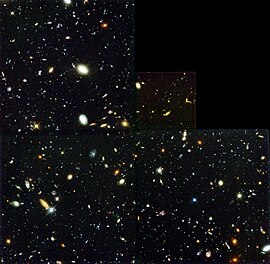
The Hubble Deep Field (HDF) is an image of a small region in the constellation Ursa Major, constructed from a series of observations by the Hubble Space Telescope. It covers an area 2.5 arcminutes across, two parts in a million of the whole sky, which is equivalent in angular size to a 65 mm tennis ball at a distance of 100 metres. The image was assembled from 342 separate exposures taken with the Space Telescope's Wide Field and Planetary Camera 2 over ten consecutive days between December 18 and December 28, 1995.
The field is so small that only a few foreground stars in the Milky Way lie within it; thus, almost all of the 3,000 objects in the image are galaxies, some of which are among the youngest and most distant known. By revealing such large numbers of very young galaxies, the HDF has become a landmark image in the study of the early universe, with the associated scientific paper having received over 800 citations by the end of 2008.
Three years after the HDF observations were taken, a region in the south celestial hemisphere was imaged in a similar way and named the Hubble Deep Field South. The similarities between the two regions strengthened the belief that the universe is uniform over large scales and that the Earth occupies a typical region in the universe (the cosmological principle). A wider but shallower survey was also made as part of the Great Observatories Origins Deep Survey. In 2004 a deeper image, known as the Hubble Ultra Deep Field (HUDF), was constructed from a total of eleven days of observations. The HUDF image is the deepest (most sensitive) astronomical image ever made at visible wavelengths.
Portal:Star/Selected article/5
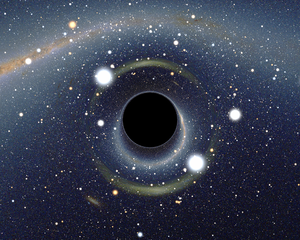
According to the general theory of relativity, a black hole is a region of space from which nothing, including light, can escape. It is the result of the deformation of spacetime caused by a very compact mass. Around a black hole there is an undetectable surface which marks the point of no return, called an event horizon. It is called "black" because it absorbs all the light that hits it, reflecting nothing, just like a perfect black body in thermodynamics. Under the theory of quantum mechanics black holes possess a temperature and emit Hawking radiation.
Despite its invisible interior, a black hole can be observed through its interaction with other matter. A black hole can be inferred by tracking the movement of a group of stars that orbit a region in space. Alternatively, when gas falls into a stellar black hole from a companion star, the gas spirals inward, heating to very high temperatures and emitting large amounts of radiation that can be detected from earthbound and Earth-orbiting telescopes.
Astronomers have identified numerous stellar black hole candidates, and have also found evidence of supermassive black holes at the center of galaxies. After observing the motion of nearby stars for 16 years, in 2008 astronomers found compelling evidence that a supermassive black hole of more than 4 million solar masses is located near the Sagittarius A* region in the center of the Milky Way galaxy.
Portal:Star/Selected article/6

The Crab Pulsar (PSR B0531+21) is a relatively young neutron star. The star is the central star in the Crab Nebula, a remnant of the supernova SN 1054, which was widely observed on Earth in the year 1054. Discovered in 1968, the pulsar was the first to be connected with a supernova remnant.
The optical pulsar is roughly 25 km in diameter and the pulsar "beams" rotate once every 33 milliseconds, or 30 times each second. The outflowing relativistic wind from the neutron star generates synchrotron emission, which produces the bulk of the emission from the nebula, seen from radio waves through to gamma rays. The most dynamic feature in the inner part of the nebula is the point where the pulsar's equatorial wind slams into the surrounding nebula, forming a termination shock. The shape and position of this feature shifts rapidly, with the equatorial wind appearing as a series of wisp-like features that steepen, brighten, then fade as they move away from the pulsar into the main body of the nebula. The period of the pulsar's rotation is slowing by 38 nanoseconds per day due to the large amounts of energy carried away in the pulsar wind.
The Crab Nebula is often used as a calibration source in X-ray astronomy. It is very bright in X-rays and the flux density and spectrum are known to be constant, with the exception of the pulsar itself. The pulsar provides a strong periodic signal that is used to check the timing of the X-ray detectors. In X-ray astronomy, 'crab' and 'millicrab' are sometimes used as units of flux density. A millicrab corresponds to a flux density of about 2.4x10−11 erg s−1 cm−2 (2.4x10−14 W m−2) in the 2–10 keV X-ray band, for a "crab-like" X-ray spectrum, which is roughly a powerlaw in photon energy, I(E)=9.5 E−1.1. Very few X-ray sources ever exceed one crab in brightness.
Portal:Star/Selected article/7

A solar flare is a large explosion in the Sun's atmosphere that can release as much as 6 × 1025 joules of energy. The term is also used to refer to similar phenomena in other stars, where the term stellar flare applies.
Solar flares affect all layers of the solar atmosphere (photosphere, corona, and chromosphere), heating plasma to tens of millions of kelvins and accelerating electrons, protons, and heavier ions to near the speed of light. They produce radiation across the electromagnetic spectrum at all wavelengths, from radio waves to gamma rays. Most flares occur in active regions around sunspots, where intense magnetic fields penetrate the photosphere to link the corona to the solar interior. Flares are powered by the sudden (timescales of minutes to tens of minutes) release of magnetic energy stored in the corona. If a solar flare is exceptionally powerful, it can cause coronal mass ejections.
X-rays and UV radiation emitted by solar flares can affect Earth's ionosphere and disrupt long-range radio communications. Direct radio emission at decimetric wavelengths may disturb operation of radars and other devices operating at these frequencies.
Solar flares were first observed on the Sun by Richard Christopher Carrington and independently by Richard Hodgson in 1859 as localized visible brightenings of small areas within a sunspot group. Stellar flares have also been observed on a variety of other stars.
The frequency of occurrence of solar flares varies, from several per day when the Sun is particularly "active" to less than one each week when the Sun is "quiet". Large flares are less frequent than smaller ones. Solar activity varies with an 11-year cycle (the solar cycle). At the peak of the cycle there are typically more sunspots on the Sun, and hence more solar flares.
Portal:Star/Selected article/8
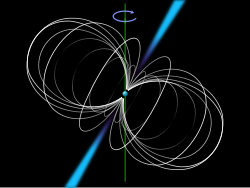
Pulsars are highly magnetized, rotating neutron stars that emit a beam of electromagnetic radiation. The observed periods of their pulses range from 1.4 milliseconds to 8.5 seconds. The radiation can only be observed when the beam of emission is pointing towards the Earth. This is called the lighthouse effect and gives rise to the pulsed nature that gives pulsars their name. Because neutron stars are very dense objects, the rotation period and thus the interval between observed pulses is very regular. For some pulsars, the regularity of pulsation is as precise as an atomic clock. A few pulsars are known to have planets orbiting them, such as PSR B1257+12. Werner Becker of the Max Planck Institute for Extraterrestrial Physics said in 2006, "The theory of how pulsars emit their radiation is still in its infancy, even after nearly forty years of work.
The events leading to the formation of a pulsar begin when the core of a massive star is compressed during a supernova, which collapses into a neutron star. The neutron star retains most of its angular momentum, and since it has only a tiny fraction of its progenitor's radius (and therefore its moment of inertia is sharply reduced), it is formed with very high rotation speed. A beam of radiation is emitted along the magnetic axis of the pulsar, which spins along with the rotation of the neutron star. The magnetic axis of the pulsar determines the direction of the electromagnetic beam, with the magnetic axis not necessarily being the same as its rotational axis. This misalignment causes the beam to be seen once for every rotation of the neutron star, which leads to the "pulsed" nature of its appearance. The beam originates from the rotational energy of the neutron star, which generates an electrical field from the movement of the very strong magnetic field, resulting in the acceleration of protons and electrons on the star surface and the creation of an electromagnetic beam emanating from the poles of the magnetic field. This rotation slows down over time as electromagnetic power is emitted. When a pulsar's spin period slows down sufficiently, the radio pulsar mechanism is believed to turn off (the so-called "death line"). As this seems to take place after ~10-100 million years, but neutron stars have been formed throughout the ~13.6 billion year age of the universe, more than 99% of neutron stars are thought to no longer be pulsars. To date, the slowest observed pulsar has a period of 8 seconds.
Portal:Star/Selected article/9
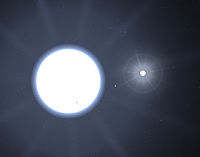
A white dwarf, also called a 'degenerate dwarf, is a small star composed mostly of electron-degenerate matter. They are very dense; a white dwarf's mass is comparable to that of the Sun and its volume is comparable to that of the Earth. Its faint luminosity comes from the emission of stored thermal energy. In January 2009, the Research Consortium on Nearby Stars project counted eight white dwarfs among the hundred star systems nearest the Sun. The unusual faintness of white dwarfs was first recognized in 1910 by Henry Norris Russell, Edward Charles Pickering, and Williamina Fleming; the name white dwarf was coined by Willem Luyten in 1922.
White dwarfs are thought to be the final evolutionary state of all stars whose mass is not high enough to become a neutron star—over 97% of the stars in our galaxy. After the hydrogen–fusing lifetime of a main-sequence star of low or medium mass ends, it will expand to a red giant which fuses helium to carbon and oxygen in its core by the triple-alpha process. If a red giant has insufficient mass to generate the core temperatures required to fuse carbon, around 1 billion K, an inert mass of carbon and oxygen will build up at its center. After shedding its outer layers to form a planetary nebula, it will leave behind this core, which forms the remnant white dwarf. Usually, therefore, white dwarfs are composed of carbon and oxygen. If the mass of the progenitor is above 8 solar masses but below 10.5 solar masses, the core temperature suffices to fuse carbon but not neon, in which case an oxygen-neon–magnesium white dwarf may be formed.appear to have been formed by mass loss in binary systems.
The material in a white dwarf no longer undergoes fusion reactions, so the star has no source of energy, nor is it supported by the heat generated by fusion against gravitational collapse. It is supported only by electron degeneracy pressure, causing it to be extremely dense. The physics of degeneracy yields a maximum mass for a non-rotating white dwarf, the Chandrasekhar limit—approximately 1.4 solar mass—beyond which it cannot be supported by electron degeneracy pressure. A carbon-oxygen white dwarf that approaches this mass limit, typically by mass transfer from a companion star, may explode as a Type Ia supernova via a process known as carbon detonation.
Portal:Star/Selected article/10
In astronomy, stellar classification is a classification of stars based on their spectral characteristics. The spectral class of a star is a designated class of a star describing the ionization of its chromosphere, what atomic excitations are most prominent in the light, giving an objective measure of the temperature in this chromosphere. Light from the star is analyzed by splitting it up by a diffraction grating, subdividing the incoming photons into a spectrum exhibiting a rainbow of colors interspersed by absorption lines, each line indicating a certain ion of a certain chemical element. The presence of a certain chemical element in such an absorption spectrum primarily indicates that the temperature conditions are suitable for a certain excitation of this element. If the star temperature has been determined by a majority of absorption lines, unusual absences or strengths of lines for a certain element may indicate an unusual chemical composition of the chromosphere.
Most stars are currently classified using the letters O, B, A, F, G, K, and M (usually memorized by astrophysicists as "Oh, be a fine girl/guy, kiss me"), where O stars are the hottest and the letter sequence indicates successively cooler stars up to the coolest M class. According to informal tradition, O stars are called "blue", B "blue-white", A stars "white", F stars "yellow-white", G stars "yellow", K stars "orange", and M stars "red", even though the actual star colors perceived by an observer may deviate from these colors depending on visual conditions and individual stars observed. The current non-alphabetical scheme developed from an earlier scheme using all letters from A to O; the original letters were retained but the star classes were re-ordered in the current temperature order when the connection between the stars' class and temperatures became clear. A few star classes were dropped as duplicates of others.
Portal:Star/Selected article/11

A circumpolar star is a star that, as viewed from a given latitude on Earth, never sets (that is, never disappears below the horizon), due to its proximity to one of the celestial poles. Circumpolar stars are therefore visible from said location towards nearest pole for the entire night on every night of the year (and would be continuously visible throughout the day too, were they not overwhelmed by the Sun's glare). All circumpolar stars are within the circumpolar circle. This was in fact the original meaning of "Arctic Circle", before the current geographical meaning, meaning "Circle of the Bears" (Ursa Major, the Great Bear; and Ursa Minor, the Little Bear), from Greek αρκτικός (arktikos), "near the Bear", from the word άρκτος (arktos) bear.
As Earth spins daily on its axis, the stars appear to rotate in circular paths around one of the celestial poles (the north celestial pole for observers in the Northern Hemisphere, or the south celestial pole for observers in the Southern Hemisphere). Stars far from a celestial pole appear to rotate in large circles; stars located very close to a celestial pole rotate in small circles and hence hardly seem to engage in any diurnal motion at all. Depending on the observer's latitude on Earth, some stars — the circumpolar ones — are close enough to the celestial pole to remain continuously above the horizon, while other stars dip below the horizon for some portion of their daily circular path (and others remain permanently below the horizon).
The circumpolar stars appear to lie within a circle that is centered at the celestial pole and tangential to the horizon. At the Earth's North Pole, the north celestial pole is directly overhead, and all stars that are visible at all (that is, all stars in the northern celestial hemisphere) are circumpolar. As one travels south, the north celestial pole moves towards the northern horizon. More and more stars that are at a distance from it begin to disappear below the horizon for some portion of their daily "orbit", and the circle containing the remaining circumpolar stars becomes increasingly small. At the Earth's equator this circle vanishes to a single point – the celestial pole itself – which lies on the horizon, and there are therefore effectively no circumpolar stars at all.
Portal:Star/Selected article/12

Stellar evolution is the process by which a star undergoes a sequence of radical changes during its lifetime. Depending on the mass of the star, this lifetime ranges from only a few million years for the most massive to trillions of years for the least massive, which is considerably longer than the age of the universe.
All stars are born from collapsing clouds of gas and dust, often called nebulae or molecular clouds. Nuclear fusion powers a star for most of its life. Stars similar to our Sun gradually grow in size until they reach a red giant phase, after which the core collapses into a dense white dwarf and the outer layers are expelled as a planetary nebula. Larger stars can explode in a supernova as their cores collapse into an extremely dense neutron star or black hole. It is not clear how red dwarfs die because of their extremely long life spans, but they probably experience a gradual death in which their outer layers are expelled over time. Stellar evolution is not studied by observing the life of a single star, as most stellar changes occur too slowly to be detected, even over many centuries. Instead, astrophysicists come to understand how stars evolve by observing numerous stars at various points in their lifetime, and by simulating stellar structure using computer models.
A stellar evolutionary model is a mathematical model that can be used to compute the evolutionary phases of a star from its formation until it becomes a remnant. The mass and chemical composition of the star are used as the inputs, and the luminosity and surface temperature are the only constraints. The model formulae are based upon the physical understanding of the star, usually under the assumption of hydrostatic equilibrium.
Portal:Star/Selected article/13

Stars of different mass and age have varying internal structures. Stellar structure models describe the internal structure of a star in detail and make detailed predictions about the luminosity, the color and the future evolution of the star. Different layers of the stars transport heat up and outwards in different ways, primarily convection and radiative transfer, but thermal conduction is important in white dwarfs. The internal structure of a main sequence star depends upon the mass of the star.
In solar mass stars (0.3–1.5 solar masses), including the Sun, hydrogen-to-helium fusion occurs primarily via proton-proton chains, which do not establish a steep temperature gradient. Thus, radiation dominates in the inner portion of solar mass stars. The outer portion of solar mass stars is cool enough that hydrogen is neutral and thus opaque to ultraviolet photons, so convection dominates. Therefore, solar mass stars have radiative cores with convective envelopes in the outer portion of the star. In massive stars (greater than about 1.5 solar masses), the core temperature is above about 1.8×107 K, so hydrogen-to-helium fusion occurs primarily via the CNO cycle. In the CNO cycle, the energy generation rate scales as the temperature to the 17th power, whereas the rate scales as the temperature to the 4th power in the proton-proton chains. Due to the strong temperature sensitivity of the CNO cycle, the temperature gradient in the inner portion of the star is steep enough to make the core convective.
The simplest commonly used model of stellar structure is the spherically symmetric quasi-static model, which assumes that a star is in a steady state and that it is spherically symmetric. It contains four basic first-order differential equations: two represent how matter and pressure vary with radius; two represent how temperature and luminosity vary with radius.
Portal:Star/Selected article/14

In astronomy and physical cosmology, the metallicity (also called Z) of an object is the proportion of its matter made up of chemical elements other than hydrogen and helium. Since stars, which comprise most of the visible matter in the universe, are composed mostly of hydrogen and helium, astronomers use for convenience the blanket term "metal" to describe all other elements collectively. Thus, a nebula rich in carbon, nitrogen, oxygen, and neon would be "metal-rich" in astrophysical terms even though those elements are non-metals in chemistry. This term should not be confused with the usual definition of "metal"; metallic bonds are impossible within stars, and the very strongest chemical bonds are only possible in the outer layers of cool K and M stars. Normal chemistry therefore has little or no relevance in stellar interiors.
The metallicity of an astronomical object may provide an indication of its age. When the universe first formed, according to the Big Bang theory, it consisted almost entirely of hydrogen which, through primordial nucleosynthesis, created a sizeable proportion of helium and only trace amounts of lithium and beryllium and no heavier elements. Therefore, older stars have lower metallicities than younger stars such as our Sun.
Stellar populations are categorized as I, II, and III, with each group having decreasing metal content and increasing age. The populations were named in the order they were discovered, which is the reverse of the order they were created. Thus, the first stars in the universe (low metal content) were population III, and recent stars (high metallicity) are population I. While older stars do have fewer heavy elements, the fact that all stars observed have some heavier elements poses something of a puzzle, and the current explanation for this proposes the existence of hypothetical metal-free Population III stars in the early universe.
Portal:Star/Selected article/15


Stellar nucleosynthesis is the collective term for the nucleosynthesis, or nuclear reactions, taking place in stars to build the nuclei of the elements heavier than hydrogen. Some small quantity of these reactions also occur on the stellar surface under various circumstances. For the creation of elements during the explosion of a star, the term supernova nucleosynthesis is used.
The processes involved began to be understood early in the 20th century, when it was first realized that the energy released from nuclear reactions accounted for the longevity of the Sun as a source of heat and light. The prime energy producer in the sun is the fusion of hydrogen to helium, which occurs at a minimum temperature of 3 million kelvin.
Hydrogen burning is an expression that astronomers sometimes use for the stellar process that results in the nuclear fusion of four protons to form a nucleus of helium-4. (This should not be confused with the combustion of hydrogen in an oxidizing atmosphere.) There are two predominant processes by which stellar hydrogen burning occurs.
Portal:Star/Selected article/16

A stellar magnetic field is a magnetic field generated by the motion of conductive plasma inside a star. This motion is created through convection, which is a form of energy transport involving the physical movement of material. A localized magnetic field exerts a force on the plasma, effectively increasing the pressure without a comparable gain in density. As a result the magnetized region rises relative to the remainder of the plasma, until it reaches the star's photosphere. This creates starspots on the surface, and the related phenomenon of coronal loops.
The magnetic field of a star can be measured by means of the Zeeman effect. Normally the atoms in a star's atmosphere will absorb certain frequencies of energy in the electromagnetic spectrum, producing characteristic dark absorption lines in the spectrum. When the atoms are within a magnetic field, however, these lines become split into multiple, closely spaced lines. The energy also becomes polarized with an orientation that depends on orientation of the magnetic field. Thus the strength and direction of the star's magnetic field can be determined by examination of the Zeeman effect lines.
A star with a magnetic field will generate a magnetosphere that extends outward into the surrounding space. Field lines from this field originate at one magnetic pole on the star then end at the other pole, forming a closed loop. The magnetosphere contains charged particles that are trapped from the stellar wind, which then move along these field lines. As the star rotates, the magnetosphere rotates with it, dragging along the charged particles.
Portal:Star/Selected article/17
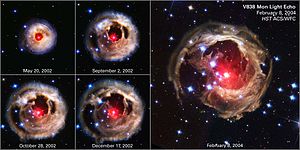
A variable star can be classifies when its apparent magnitude as seen from Earth changes over time, whether the changes are due to variations in the star's actual luminosity, or to variations in the amount of the star's light that is blocked from reaching Earth. Many, possibly most, stars have at least some variation in luminosity: the energy output of our Sun, for example, varies by about 0.1% over an 11 year solar cycle, equivalent to a change of one thousandth of its magnitude.
It is convenient to classify variable stars as belonging to one of two types:
- Intrinsic variables, whose luminosity actually changes; for example, because the star periodically swells and shrinks.
- Extrinsic variables, whose apparent changes in brightness are due to changes in the amount of their light that can reach Earth; for example, because the star has an orbiting companion that sometimes eclipses it.
The first variable star was identified in 1638 when Johannes Holwarda noticed that Omicron Ceti (later named Mira) pulsated in a cycle taking 11 months; the star had previously been described as a nova by David Fabricius in 1596. This discovery, combined with supernovae observed in 1572 and 1604, proved that the starry sky was not eternally invariable as Aristotle and other ancient philosophers had taught. In this way, the discovery of variable stars contributed to the astronomical revolution of the sixteenth and early seventeenth centuries.
Variable stars are generally analysed using photometry, spectrophotometry and spectroscopy. Measurements of their changes in brightness can be plotted to produce light curves. For regular variables, the period of variation and its amplitude can be very well established; for many variable stars, though, these quantities may vary slowly over time, or even from one period to the next. Peak brightnesses in the light curve are known as maxima, while troughs are known as minima.
Portal:Star/Selected article/18

A corona is a type of plasma "atmosphere" of the Sun or other celestial body, extending millions of kilometers into space, most easily seen during a total solar eclipse, but also observable in a coronagraph. The Latin root of the word corona means crown.
The high temperature of the corona gives it unusual spectral features, which led some to suggest, in the 19th century, that it contained a previously unknown element, "coronium". These spectral features have since been traced to highly ionized iron (Fe-XIV) which indicates a plasma temperature in excess of 106 kelvin. The fact that the Sun has a million degree corona was first discovered by Gotrian in 1939 and Bengt Edlén in 1941 by identifying the coronal lines (observed since 1869) as transitions from low lying metastable levels of the ground configuration of highly ionized metals (the green FeXIV line at 5303 Å, but also the red line FeX at 6374 Å).
Light from the corona comes from three primary sources, which are called by different names although all of them share the same volume of space. The K-corona (K for kontinuierlich, "continuous" in German) is created by sunlight scattering off free electrons; Doppler broadening of the reflected photospheric absorption lines completely obscures them, giving the spectral appearance of a continuum with no absorption lines. The F-corona (F for Fraunhofer) is created by sunlight bouncing off dust particles, and is observable because its light contains the Fraunhofer absorption lines that are seen in raw sunlight; the F-corona extends to very high elongation angles from the Sun, where it is called the Zodiacal light. The E-corona (E for emission) is due to spectral emission lines produced by ions that are present in the coronal plasma; it may be observed in broad or forbidden or hot spectral emission lines and is the main source of information about the corona's composition. The sun's corona is much hotter (by a factor of nearly 200) than the visible surface of the Sun: the photosphere's average temperature is 5800 kelvin compared to the corona's one to three million kelvin.
Portal:Star/Selected article/19
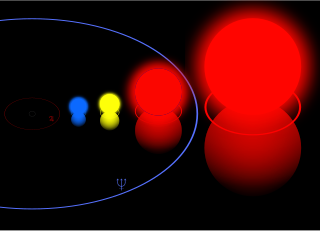
The solar mass () is a standard unit of mass in astronomy, used to indicate the masses of other stars, as well as clusters, nebulae and galaxies. It is equal to the mass of the Sun, about two nonillion kilograms. This is about 332,950 times the mass of the Earth or 1,048 times the mass of Jupiter. Because the Earth follows an elliptical orbit around the Sun, the solar mass can be computed from the equation for the orbital period of a small body orbiting a central mass. Based upon the length of the year, the distance from the Earth to the Sun (an astronomical unit or AU), and the gravitational constant (G).
The value of the gravitational constant was derived from 1798 measurements by Henry Cavendish using a torsion balance. The value obtained differed only by about 1% from the modern value.The diurnal parallax of the Sun was accurately measured during the transits of Venus in 1761 and 1769, yielding a value of 9″ (compared to the present 1976 value of 8.794148″). When the value of the diurnal parallax is known, the distance to the Sun can be determined from the geometry of the Earth. The first person to estimate the mass of the Sun was Isaac Newton. In his work Principia, he estimated that the ratio of the mass of the Earth to the Sun was about 1/28,700. Later he determined that this value was based upon a faulty value for the solar parallax, which was used to estimate the distance to the Sun (1 AU). He revised his result to obtain a ratio of 1/169,282 in the third edition of the Principia. The current value for the solar parallax is smaller still, giving a mass ratio of 1/332,946.
As a unit of measurement, the solar mass came into use before the AU and the gravitational constant were precisely measured. This is because the determination of the relative mass of another planet in the Solar System or of a binary star in units of solar masses does not depend on these poorly known constants. So it was useful to express these masses in units of solar masses (see Gaussian gravitational constant).
The mass of the Sun changes slowly, compared to the lifetime of the Sun. Mass is lost due to two main processes in nearly equal amounts. First, in the Sun's core hydrogen is converted into helium by nuclear fusion, in particular the pp chain. Thereby mass is converted to energy in correspondence to the mass–energy equivalence. This energy is eventually radiated away by the Sun. The second process is the solar wind, which is the ejection of mainly protons and electrons to outer space. The actual net mass of the Sun since it reached the main sequence remains uncertain. The early Sun had much higher mass loss rates than at present, so, realistically, it may have lost anywhere from 1–7% of its total mass over the course of its main sequence lifetime.
Portal:Star/Selected article/20

A binary star is a star system consisting of two stars orbiting around their common center of mass. The brighter star is called the primary and the other is its companion star, comes, or secondary. Research between the early 19th century and today suggests that many stars are part of either binary star systems or star systems with more than two stars, called multiple star systems. The term double star may be used synonymously with binary star, but more generally, a double star may be either a binary star or an optical double star which consists of two stars with no physical connection but which appear close together in the sky as seen from the Earth. A double star may be determined to be optical if its components have sufficiently different proper motions or radial velocities, or if parallax measurements reveal its two components to be at sufficiently different distances from the Earth. Most known double stars have not yet been determined to be either bound binary star systems or optical doubles.
Binary star systems are very important in astrophysics because calculations of their orbits allow the masses of their component stars to be directly determined, which in turn allows other stellar parameters, such as radius and density, to be indirectly estimated. This also determines an empirical mass-luminosity relationship (MLR) from which the masses of single stars can be estimated.
Binary stars are often detected optically, in which case they are called visual binaries. Many visual binaries have long orbital periods of several centuries or millennia and therefore have orbits which are uncertain or poorly known. They may also be detected by indirect techniques, such as spectroscopy (spectroscopic binaries) or astrometry (astrometric binaries). If a binary star happens to orbit in a plane along our line of sight, its components will eclipse and transit each other; these pairs are called eclipsing binaries, or, as they are detected by their changes in brightness during eclipses and transits, photometric binaries.
If components in binary star systems are close enough they can gravitationally distort their mutual outer stellar atmospheres. In some cases, these close binary systems can exchange mass, which may bring their evolution to stages that single stars cannot attain. Examples of binaries are Sirius and Cygnus X-1 (of which one member is probably a black hole). Binary stars are also common as the nuclei of many planetary nebulae, and are the progenitors of both novae and type Ia supernovae.
Portal:Star/Selected article/21
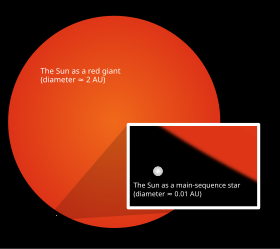
A red giant is a luminous giant star of low or intermediate mass (roughly 0.5–10 solar masses) in a late phase of stellar evolution. The outer atmosphere is inflated and tenuous, making the radius immense and the surface temperature low, somewhere from 5,000 K and lower. The appearance of the red giant is from yellow orange to red, including the spectral types K and M, but also class S stars and most carbon stars.
The most common red giants are the so-called red giant branch stars (RGB stars) whose shells are still fusing hydrogen into helium, while the core is inactive helium. Another case of red giants are the asymptotic giant branch stars (AGB) that produce carbon from helium by the triple-alpha process. To the AGB stars belong the carbon stars of type C-N and late C-R. Prominent bright red giants in the night sky include Aldebaran (Alpha Tauri), Arcturus (Alpha Bootis), and Gamma Crucis (Gacrux), while the even larger Antares (Alpha Scorpii) and Betelgeuse (Alpha Orionis) are red supergiants.
Red giants are stars that have exhausted the supply of hydrogen in their cores and switched to thermonuclear fusion of hydrogen in a shell surrounding the core. They have radii tens to hundreds of times larger than that of the Sun. However, their outer envelope is lower in temperature, giving them an orange hue. Despite the lower energy density of their envelope, red giants are many times more luminous than the Sun because of their large size. Main sequence stars of spectral types A through K are believed to evolve into red giants. The Sun is predicted to become a red giant in approximately 7.5 billion years. It is calculated that the Sun will become sufficiently large to engulf the current orbits of the Solar System's inner planets, up to Earth.
Portal:Star/Selected article/22

A protostar is a large mass that forms by contraction out of the gas of a giant molecular cloud in the interstellar medium. The protostellar phase is an early stage in the process of star formation. For a one solar-mass star it lasts about 100,000 years. It starts with a core of increased density in a molecular cloud and ends with the formation of a T Tauri star, which then develops into a main sequence star. This is heralded by the T Tauri wind, a type of super solar wind that marks the change from the star accreting mass into radiating energy.
Observations have revealed that giant molecular clouds are approximately in a state of virial equilibrium—on the whole, the gravitational binding energy of the cloud is balanced by the thermal pressure of the cloud's constituent molecules and dust particles. Although thermal pressure is likely the dominant effect in counteracting gravitational collapse of protostellar cores, magnetic pressure, turbulence and rotation can also play a role (Larson, 2003). Any disturbance to the cloud may upset its state of equilibrium. Examples of disturbances are shock waves from supernovae; spiral density waves within galaxies and the close approach or collision of another cloud. If the disturbance is sufficiently large, it may lead to gravitational instability and subsequent collapse of a particular region of the cloud.
The British physicist Sir James Jeans considered the above phenomenon in detail. He was able to show that, under appropriate conditions, a cloud, or part of one, would start to contract very swiftly as described above. He derived a formula for calculating the mass and size that a cloud would have to reach as a function of its density and temperature before gravitational contraction would begin. This critical mass is known as the Jeans mass. The existence of 'protostars' was first proposed and postulated by Soviet-Armenian scientist, Viktor Ambartsumian.
Portal:Star/Selected article/23 Portal:Stars/Selected article/23
Portal:Star/Selected article/24 Portal:Stars/Selected article/24
Portal:Star/Selected article/25 Portal:Stars/Selected article/25
Portal:Star/Selected article/26 Portal:Stars/Selected article/26

